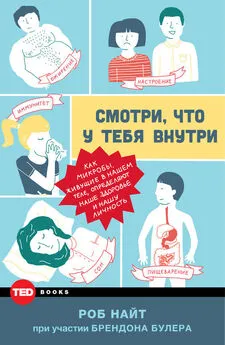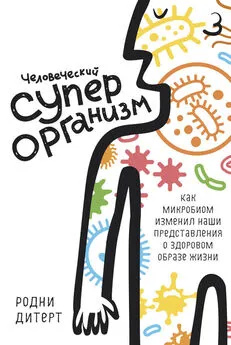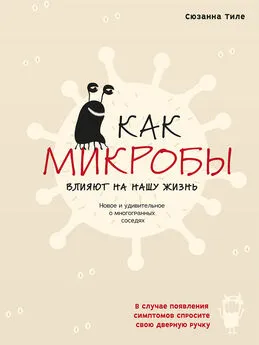Роб Найт - Смотри, что у тебя внутри. Как микробы, живущие в нашем теле, определяют наше здоровье и нашу личность
- Название:Смотри, что у тебя внутри. Как микробы, живущие в нашем теле, определяют наше здоровье и нашу личность
- Автор:
- Жанр:
- Издательство:АСТ: CORPUS
- Год:2015
- Город:Москва
- ISBN:978-5-17-091312-1
- Рейтинг:
- Избранное:Добавить в избранное
-
Отзывы:
-
Ваша оценка:
Роб Найт - Смотри, что у тебя внутри. Как микробы, живущие в нашем теле, определяют наше здоровье и нашу личность краткое содержание
Смотри, что у тебя внутри. Как микробы, живущие в нашем теле, определяют наше здоровье и нашу личность - читать онлайн бесплатно полную версию (весь текст целиком)
Интервал:
Закладка:
30
O. Koren et al., “Host Remodeling of the Gut Microbiome and Metabolic Changes During Pregnancy,” Cell 150, no. 3 (August 3, 2012): 470–80.
31
K. Aagaard et al., “The Placenta Harbors a Unique Microbiome,” Science Translational Medicine 6, no. 237 (May 21, 2014): 237ra65.
32
Romero et al., “Composition and Stability of Vaginal Microbiota of Normal Pregnant Women Different from That of Non-Pregnant Women.”
33
Michelle K. Osterman and Joyce A. Martin, “Changes in Cesarean Delivery Rates by Gestational Age: United States, 1996–2011,” NCHS Data Brief , no. 124, June 2013: 1–8; Luz Gibbons et al., The Global Numbers and Costs of Additionally Needed and Unnecessary Cesarean Sections Performed per Year: Overuse as a Barrier to Universal Coverage . Geneva, Switzerland: World Health Organization, 2010.
34
M. G. Dominguez-Bello et al., “Delivery Mode Shapes the Acquisition and Structure of the Initial Microbiota Across Multiple Body Habitats in Newborns,” Proceedings of the National Academy of Sciences of the United States of America 107, no. 26 (June 29, 2010): 11971–75.
35
G. V. Guibas et al., “Conception via In Vitro Fertilization and Delivery by Caesarean Section Are Associated with Paediatric Asthma Incidence,” Clinical and Experimental Allergy: Journal of the British Society for Allergy and Clinical Immunology 43, no. 9 (September 2013): 1058–66; L. Braback, A. Lowe, and A. Hjern, “Elective Cesarean Section and Childhood Asthma,” American Journal of Obstetrics and Gynecology 209, no. 5 (November 2013): 496; C. Roduit et al., “Asthma at 8 Years of Age in Children Born by Caesarean Section,” Thorax 64, no. 2 (February 2009): 107–13; M. C. Tollanes et al., “Cesarean Section and Risk of Severe Childhood Asthma: A Population-Based Cohort Study,” Journal of Pediatrics 153, no. 1 (July 2008): 112–16; B. Xu et al., “Caesarean Section and Risk of Asthma and Allergy in Adulthood,” Journal of Allergy and Clinical Immunology 107, no. 4 (April 2001): 732–33.
36
M. Z. Goldani et al., “Cesarean Section and Increased Body Mass Index in School Children: Two Cohort Studies from Distinct Socioeconomic Background Areas in Brazil,” Nutrition Journal 12, no. 1 (July 25, 2013): 104; A. A. Mamun et al., “Cesarean Delivery and the Long-term Risk of Offspring Obesity,” Obstetrics and Gynecology 122, no. 6 (December 2013): 1176–83; D. N. Mesquita et al., “Cesarean Section Is Associated with Increased Peripheral and Central Adiposity in Young Adulthood: Cohort Study,” PloS One 8, no. 6 (June 27, 2013): e66827; K. Flemming et al., “The Association Between Caesarean Section and Childhood Obesity Revisited: A Cohort Study,” Archives of Disease in Childhood 98, no. 7 (July 2013): 526–32; E. Svensson et al., “Caesarean Section and Body Mass Index Among Danish Men,” Obesity 21, no. 3 (March 2013): 429–33; H. T. Li, Y. B. Zhou, and J. M. Liu, “The Impact of Cesarean Section on Offspring Overweight and Obesity: A Systematic Review and Meta-Analysis,” International Journal of Obesity 37, no. 7 (July 2013): 893–99; H. A. Goldani et al., “Cesarean Delivery Is Associated with an Increased Risk of Obesity in Adulthood in a Brazilian Birth Cohort Study,” American Journal of Clinical Nutrition 93, no. 6 (June 2011): 1344–47; L. Zhou et al., “Risk Factors of Obesity in Preschool Children in an Urban Area in China,” European Journal of Pediatrics 170, no. 11 (November 2011): 1401–6.
37
T. Marrs et al., “Is There an Association Between Microbial Exposure and Food Allergy? A Systematic Review,” Pediatric Allergy and Immunology: Official Publication of the European Society of Pediatric Allergy and Immunology 24, no. 4 (June 2013): 311–20 e8.
38
J. Penders et al., “Establishment of the Intestinal Microbiota and Its Role for Atopic Dermatitis in Early Childhood,” Journal of Allergy and Clinical Immunology 132, no. 3 (September 2013): 601–7 e8; K. Pyrhonen et al., “Caesarean Section and Allergic Manifestations: Insufficient Evidence of Association Found in PopulationBased Study of Children Aged 1 to 4 Years,” Acta Paediatrica 102, no. 10 (October 2013): 982–89; F. A. van Nimwegen et al., “Mode and Place of Delivery, Gastrointestinal Microbiota, and Their Influence on Asthma and Atopy,” Journal of Allergy and Clinical Immunology 128, no. 5 (November 2011): 948–55 e1–3; P. Bager, J. Wohlfahrt, and T. Westergaard, “Caesarean Delivery and Risk of Atopy and Allergic Disease: Meta-Analyses,” Clinical and Experimental Allergy: Journal of the British Society for Allergy and Clinical Immunology 38, no. 4 (April 2008): 634–42; K. Negele et al., “Mode of Delivery and Development of Atopic Disease During the First 2 Years of Life,” Pediatric Allergy and Immunology: Official Publication of the European Society of Pediatric Allergy and Immunology 15, no. 1 (February 2004): 48–54.
39
M. B. Azad et al., “Gut Microbiota of Healthy Canadian Infants: Profiles by Mode of Delivery and Infant Diet at 4 Months,” CMAJ: Canadian Medical Association Journal 185, no. 5 (March 19, 2013): 385–94.
40
J. E. Koenig et al., “Succession of Microbial Consortia in the Developing Infant Gut Microbiome,” supplement 1, Proceedings of the National Academy of Sciences of the United States of America 108 (March 15, 2011): 4578–85.
41
G. D. Wu et al., “Linking Longterm Dietary Patterns with Gut Microbial Enterotypes,” Science 334, no. 6052 (October 7, 2011): 105–8.
42
G. D. Wu et al., “Linking Longterm Dietary Patterns with Gut Microbial Enterotypes,” Science 334, no. 6052 (October 7, 2011): 105–8.
43
J. Qin et al., “A Human Gut Microbial Gene Catalogue Established by Metagenomic Sequencing,” Nature 464, no. 7285 (March 4, 2010): 59–65.
44
T. Yatsunenko et al., “Human Gut Microbiome Viewed Across Age and Geography,” Nature 486, no. 7402 (May 9, 2012): 222–7.
45
J. H. Hehemann et al., “Transfer of Carbohydrate-Active Enzymes from Marine Bacteria to Japanese Gut Microbiota,” Nature 464, no. 7290 (April 8, 2010): 908–12.
46
P. J. Turnbaugh et al., “A Core Gut Microbiome in Obese and Lean Twins,” Nature 457, no. 7228 (Jan. 22, 2009): 480–4.
47
J. Genuneit et al., “The Combined Effects of Family Size and Farm Exposure on Childhood Hay Fever and Atopy,” Pediatric Allergy and Immunology: Official Publication of the European Society of Pediatric Allergy and Immunology 24, no. 3 (May 2013): 293–98.
48
S. J. Song et al., “Cohabiting Family Members Share Microbiota with One Another and with Their Dogs,” eLife 2 (April 16, 2013): e00458.
49
J. G. Caporaso et al., “Moving Pictures of the Human Microbiome,” Genome Biology 12, no. 5 (2011): R50.
50
M. J. Claesson et al., “Gut Microbiota Composition Correlates with Diet and Health in the Elderly,” Nature 488, no. 7410 (August 9, 2012): 178–84.
51
P. J. Turnbaugh et al., “DietInduced Obesity Is Linked to Marked but Reversible Alterations in the Mouse Distal Gut Microbiome,” Cell Host & Microbe 3, no. 4 (April 17, 2008): 213–23.
52
M. Vijay-Kumar et al., “Metabolic Syndrome and Altered Gut Microbiota in Mice Lacking Toll-like Receptor 5,” Science 328, no. 5975 (April 9, 2010): 228–31.
53
Ridaura et al., “Gut Microbiota from Twins Discordant for Obesity Modulate Metabolism in Mice.”
54
D. Mozaffarian et al., “Changes in Diet and Lifestyle and Long-term Weight Gain in Women and Men,” New England Journal of Medicine 364, no. 25 (June 23, 2011): 2392–404.
55
L. A. David et al., “Diet Rapidly and Reproducibly Alters the Human Gut Microbiome,” Nature 505, no. 7484 (January 23, 2014): 559–63.
56
D. P. Strachan, “Hay Fever, Hygiene, and Household Size,” British Medical Journal 299, no. 6710 (Nov. 18, 1989): 1259–60.
57
D. P. Strachan, “Is Allergic Disease Programmed in Early Life?”, Clinical & Experimental Allergy 24, no. 7 (July 1994): 603–5.
58
J. Riedler et al., “Exposure to Farming in Early Life and Development of Asthma and Allergy: A Cross-Sectional Study,” The Lancet 358, no. 9288 (Oct. 6, 2001): 1129–33.
59
S. Illi et al., “Protection from Childhood Asthma and Allergy in Alpine Farm Environments – the GABRIEL Advanced Studies,” Journal of Allergy and Clinical Immunology 129, no. 6 (June 2012): 1470–7.
60
Braun-Fahrländer et al., “Environmental Exposure to Endotoxin and Its Relation to Asthma in School-Age Children,” New England Journal of Medicine 347, no. 12 (Sept. 19, 2002): 869–77.
61
J. Douwes et al., “Does Early Indoor Microbial Exposure Reduce the Risk of Asthma? The Prevention and Incidence of Asthma and Mite Allergy Birth Cohort Study,” Journal of Allergy and Clinical Immunology 117, no. 5 (May 2006): 1067–73.
62
S. Lau et al., “Early Exposure to House-Dust Mite and Cat Allergens and Development of Childhood Asthma: a Cohort Study. Multicenter Allergy Study Group,” The Lancet 356, no. 9239 (Oct. 21, 2000): 1392–7.
63
M. J. Ege et al., “Exposure to Environmental Microorganisms and Childhood Asthma,” New England Journal of Medicine 364, no. 8 (Feb. 24, 2011): 701–9.
64
E. Y. Hsiao et al., “Microbiota Modulate Behavioral and Physiological Abnormalities Associated With Neurodevelopmental Disorders,” Cell 155, no. 7 (Dec. 19, 2013): 1451–63.
65
N. Elazab et al., “Probiotic Administration in Early Life, Atopy, and Asthma: a Meta-Analysis of Clinical Trials,” Pediatrics 132, no. 3 (Sept. 2013): 666–76.
66
A. A. Niccoli et al., “Preliminary Results on Clinical Effects of Probiotic Lactobacillus Salivarius LS01 in Children Affected by Atopic Dermatitis,” Journal of Clinical Gastroenterology 48, supplement 1 (Nov-Dec 2014): S34–6.
67
M. C. Arrieta and B. Finlay, “The Intestinal Microbiota and Allergic Asthma,” Journal of Infection 4453, no. 14 (Sept. 25, 2014): 227–8.
68
A. Du Toit, “Microbiome: Clostridia Spp. Combat Food Allergy in Mice,” National Review of Microbiology 12, no. 10 (Sept. 16, 2014): 657.
69
A. T. Stefka et al., “Commensal Bacteria Protect Against Food Allergen Sensitization,” Proceedings of the National Academy of Sciences 111, no. 36 (Sept. 9, 2014): 13145–50.
Читать дальшеИнтервал:
Закладка:





![Анна Мохова - Ты не одна [Как забыть одиночество и найти счастье внутри себя] [litres]](/books/1065776/anna-mohova-ty-ne-odna-kak-zabyt-odinochestvo-i-n.webp)




